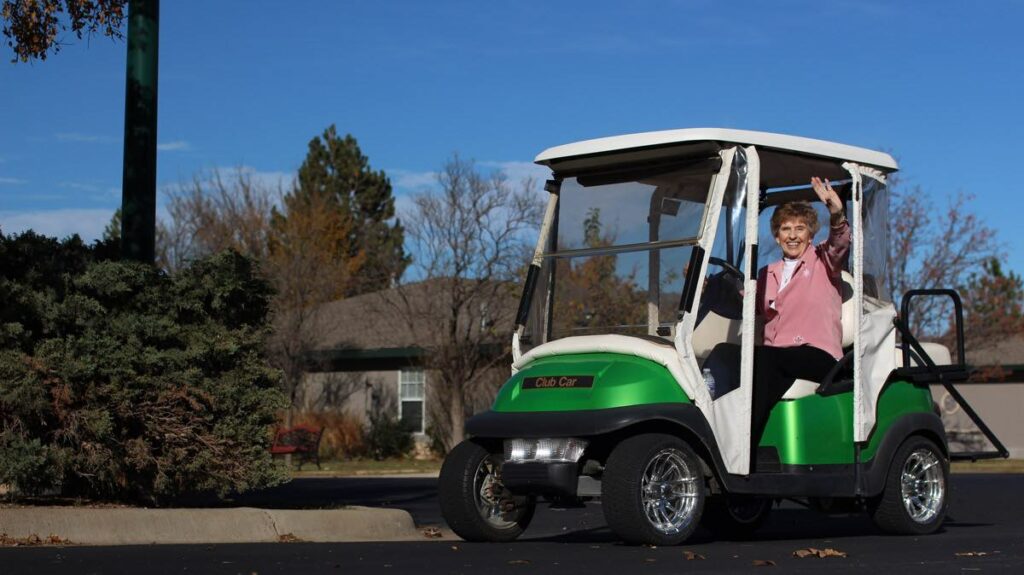
We know how important exercise is to staying healthy and active. But have we considered the role exercise can play in safe driving? There are specific steps we can take to improve coordination, muscle strength, and flexibility that can help us feel more confident and comfortable behind the wheel.
It’s important to always check with your doctor before beginning any exercise program. But reading through these suggestions can give you a good place to start when putting together questions for your next visit to your physician, who can help you determine how often to do the exercises and for how many repetitions.
Staying Strong
Muscles lose strength and mass as we age in a process called sarcopenia. Although this process is a natural part of aging, we can counteract and even reverse the effects of age-related muscle loss by exercising. Keeping leg and arm strength is essential to safe driving. Here are some easy-to-do exercises to help you stay strong behind the wheel.
- Sit-to-Stands: Begin seated in a sturdy chair without arms. Press down into the floor with your feet, feeling the engagement of your thigh muscles, and rise to a standing position without using your arms. Carefully return to a seated position making sure the chair is securely underneath you.
- Bicep Curls: From a standing or seated position, anchor your upper right arm along the side of your body. Grip a water bottle or dumbbell with your right hand (palm facing up) and slowly raise the weight towards your shoulder. Lower to a point of extension that does not lock your elbow.
Flexibility and Range of Motion
Staying flexible, particularly in the upper body and neck, can help keep us safe while driving. Flexibility means an increased range of motion, which refers to the extent of movement in a joint. For example, if we have limited range of motion in the facet joints in the neck, we may find it uncomfortable and difficult to turn our head to check for oncoming traffic. Similarly, if our shoulders have limited range of motion, lifting our arms to bring our hands to grip the steering wheel might be uncomfortable.
These exercises can help us improve flexibility and increase range of motion.
- Shoulder Stretch: Stand with feet about hip-width apart. Extend both arms straight out from the shoulders with palms facing down. Slowly raise both arms up towards the ceiling to a comfortable height. Slowly return arms to your sides.
- Chest Opener: Sit tall in a study chair without arms with your back away from the back of the chair. Gently lift shoulders up and bring shoulder blades together to gently open the chest. Now reach behind you to bring each hand to its corresponding side of the chair to help you open the chest a little more. Breathe deeply.
- Yes/No Exercise: Sitting tall in a sturdy chair, relax the shoulders down and away from the ears. Picture your chin parallel to the floor to help you lengthen through the neck. Take a deep breath in, and slowly turn your head to the right. On an exhaled breath, slowly return to center. Repeat on the left side. Keep shoulders relaxed, down, and still, moving just head and neck.
Eye Exercises
Many yoga classes include exercises that specifically target the muscles around the eyes. According to Yoga Journal, asanas, or exercises, for the eyes can help reduce the incidence of many age-related vision problems. These exercises are best done as part of relaxation, perhaps after exercising.
- Clock Face: Sit relaxed in a sturdy chair with your back against the back of the chair. Keeping your head still, look up as if you were looking at 12:00 on a large clock. Move your eyes slowly in a circular, clockwise direction around the face of the clock. After completing your circle, close your eyes to give them a rest. Repeat moving in a counterclockwise direction.
- Focal Range: Sit relaxed in a sturdy chair with your back against the back of the chair. Release shoulders down and away from the ears. Extend the right arm straight out from the shoulder with fingers curled in to the palm and thumb extended up towards the ceiling. Focusing on the thumbnail, slowly draw the arm towards the body, letting the thumb come towards the nose. Notice the change in focus as your thumb nears your body. Repeat on the left side.
Improving Coordination
The word “yoga” comes from a Sanskrit word mean “to yoke” or “to join.” The practice of yoga strives to unite mind, body, and spirit. The mind-body connection nurtured by yoga practice naturally lends itself balancing aspects of the body and movement, so, not surprisingly, the discipline of yoga also offers us ways to improve our coordination. Here is simple exercise from the practice of chair yoga that can help improve coordination.
- Opposite arm/leg movement: Sit relaxed in a sturdy chair with your back against the back of the chair. Release shoulders down and away from the ears. Hold onto the outside of the seat of the chair with your left hand if you have any concerns regarding your low back. Slowly raise and extend your left leg, extending without locking the knee. Extend and raise the right arm to a comfortable height with hand open and thumb pointing up towards the ceiling. Lower leg and arm. Practice so that you are able to raise and then lower left leg and right arm at the same time. Repeat on the opposite sides.
Grip Strength
According to SilverSneakers, a health and fitness program dedicated to older adults, grip strength is an important measure of overall body strength and muscle tone. Also, hand strength is the key to maintaining independence in activities of daily living. Grip strength can also be a component of safe driving, whether we’re holding the steering wheel or the gear shift knob. These exercises can help strengthen the muscles that keep our grip strong.
- Clench and Extend: Anchoring the upper right arm against the body, slowly draw the fingers together to make a fist. Slowly extend the fingers, creating a “starfish” by reaching fingers out. Repeat on the left side.
- Isolated Wrist Curls: Holding a very light dumbbell or water bottle, lean forward in your sturdy chair to rest your right forearm on your right thigh. Moving just your wrist, slowly raise and lower your weight to engage the wrist and muscles of the forearm. Repeat on the opposite side. Be sure to use very light weight—or no weight—and move slowly within an appropriate range of motion.
Additional Resources
- More on Senior Fitness, including online classes and videos: https://www.silversneakers.com/
- Additional information on eye exercises: https://www.yogajournal.com/lifestyle/health/ayurveda/practices/insight-for-sore-eyes/
- Strength training for seniors:
